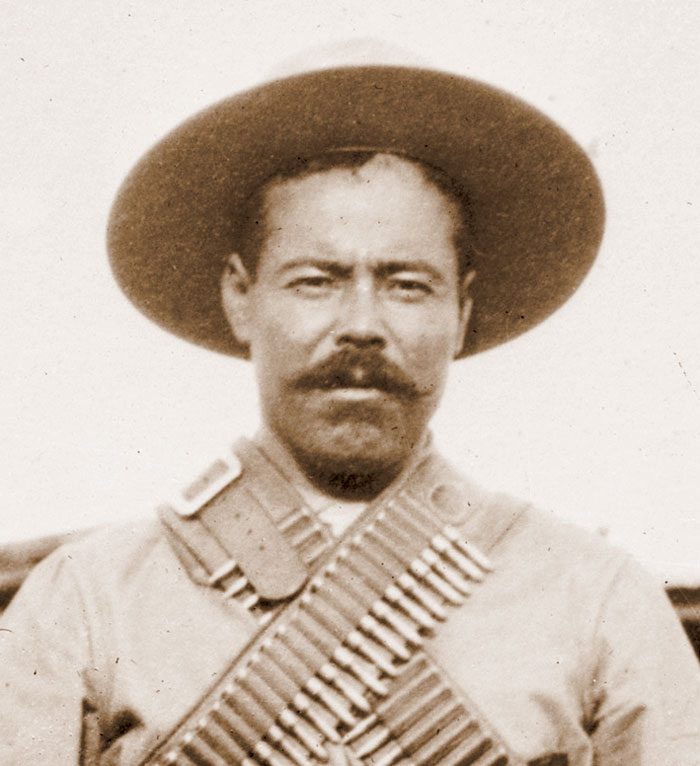Pancho Villa

According to legend, José Doroteo Arango Arámbula was forced into a life of mountain banditry after murdering a wealthy hacienda owner who’d raped his sister. He changed his name to Pancho Villa (La Cucaracha, the cockroach, to his friends), became the leader of his gang, robbed from the rich, gave to the poor, and married 75 women!
The Mexican Revolution made an honest man of him. Serving Francisco Madero as colonel, Villa and fellow revolutionary Pascual Orozco captured the vital city of Ciudad Juárez (in defiance of Madero’s orders), thus forcing Porfirio Díaz to resign. Although he shared his fellow revolutionaries’ disillusionment with Madero as the new president, he defended him against Orozco’s counter revolution.
Villa earned his greatest fame, however, by leading the opposition to the dictator who’d ordered Madero’s assassination, Victoriano Huerta. Commanding the apparently invincible Division of the North, he forbade his troops to engage in any drinking or looting. In fact, wherever he conquered, he distributed land and built schools. His military exploits were so wildly successful that the United States military studied his tactics, and Hollywood featured him in a documentary movie. (The producers bought new uniforms for his troops, so they’d appear more soldierly on film.) “My sole ambition,” Villa explained to the fawning press, “is to rid Mexico of that class that has oppressed her and give the people a chance to know what real liberty means.”
Once again disobeying his commander (this time, Venustiano Carranza), he captured Zacatecas in the bloodiest battle of the revolution and forced Huerta into exile.
The trouble was, Villa and his fellow victors neither liked nor trusted each other, and their disagreements soon devolved into another civil war, with Emiliano Zapata and Villa teaming up against Carranza and his general, Álvaro Obregón. Their arguments were many and complicated, but a crucial one was the fact that both Zapata and Villa insisted on dramatic social and land reform.
This is when everything fell apart for Villa. After a series of catastrophic defeats to Obregón (who’d studied WWI trench-warfare tactics), his famed Division of the North, which at its height had boasted as many as 50,000 soldiers, was eventually reduced to merely 200 guerillas.
Bitter and frustrated, Villa became ruthless. When the villagers from San Pedro de las Cuevas attacked some of his soldiers, apparently believing them to be bandits, Villa ordered the massacre of 83 men, including the village priest. Two years later, when another town, Namiquipa, turned against him, and the village men fled to the hills, Villa ordered all the women to be raped, then burned the town to the ground.
Villa didn’t spare even the United States from his wrath. After President Wilson transferred his support from Villa to the victorious Carranza, Villa murdered 16 American engineers, then attacked the town of Columbus, New Mexico (thus becoming the only Latin American to ever invade the United States, while the US has invaded its southern neighbors more than 50 times). He subsequently led the 5,000-troop US punitive force on a humiliating wild-goose chase through the Mexican mountains. (Mexicans still chuckle at that!)
Once Obregón assassinated Carranza, Villa negotiated a generous retirement for himself and his few remaining loyal fighters on an abandoned hacienda near Durango. (Did he give up? Accept reality? Sell out?)
There, Villa created an idyllic community. According to Mexican journalist/historian Froilán Meza Rivera, “Villa organized communal work; turned the church into a barn; bought agricultural machinery; planted wheat, corn, and beans; founded an agricultural credit bank; installed carpentry and shoe shops; and he built a school for the children and houses for the workers. Villa’s productive project was a model of communal production, cooperative style, and is a sample of what the revolutionary caudillo wanted for Mexico: a country without hunger, productive, without exploiters or exploited, and with a growing education that would train the children as good men, endowed with great knowledge and a comprehensive, humanistic, justice, and revolutionary training.”
Nonetheless, when Villa began to speak about possibly running for public office, Obregón and Plutarco Elias Calles had him assassinated.
Uneducated, brilliant, irascible, visionary, enigmatic, colorful, larger than life, ever controversial, Pancho Villa remains Mexico’s favorite scoundrel.
This is a selection from Ellison’s recently published book, Mexican Streets: Tales of Tragedy and Triumph, available at Amazon, Handy Mail, and Diane Pearl’s.
- Streets of Mexico – August 2025 - July 29, 2025
- Streets of Mexico – July 2025 - June 29, 2025
- Streets of Mexico – June 2025 - May 29, 2025


 Discover trusted local services and hidden gems with our easy-to-use online directory.
Discover trusted local services and hidden gems with our easy-to-use online directory.

